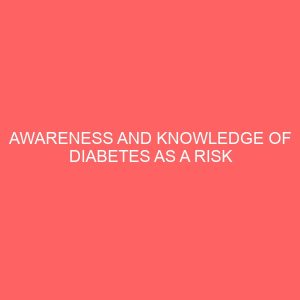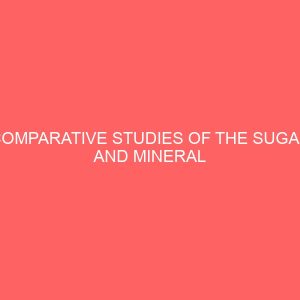Description
CHAPTER ONE 1.0 INTRODUCTION
Insect-transmitted diseases remain a major cause of morbidity and mortality worldwide. Mosquito species belonging to genera; Anopheles, Aedes and Culex, are vectors (Redwane et al., 2002) for the transmission of malaria, dengue fever, yellow fever, filariasis, schistosomiasis and Japanese encephalitis (JE), transmitting diseases to more than 700 million people annually (Oyewole et al., 2010; Govindarajan, 2009). Mosquitoes also cause allergic responses in humans which include local skin irritation and systemic reactions such as angioedema. Aedes spp are generally regarded as a vector responsible for transmission of yellow fever and dengue fever, which is endemic to Southeast Asia, the Pacific island area, Africa, Central and South America.
The World Health Organization (W.H.O. 2012) has recommended vector control as an important component of the global strategy for preventing insect-transmitted diseases. The most commonly employed method for the control of mosquito-borne diseases involve the use of chemical-based insecticide, though it is not without numerous challenges, such as human and environmental toxicity, resistance, affordability and availability (Ghosh et al., 2012).
Extracts from plants has been good sources of phytochemicals as mosquito egg and larval control agents, since they constitute an abundant source of bioactive compounds that are easily biodegradable into non-toxic products. In fact, many researchers have reported on the effectiveness of plant extracts or essential oils against mosquito larvae. They act as larvicides, insect growth regulators, repellents, and oviposition attractants (Pushpanathan, 2008; Samidurai et al., 2009; Mathivanant et al., 2010).
Persea Americana is an ever green tree belonging to Lauraceae family and its fruits are commonly known as avocado pear or alligator pear. The plant originates from Central America but it has shown easy adaptation to other tropical regions, thus widely cultivated in tropical and subtropical regions. The various parts (leaves, fruits and seed) of this plant have numerous uses from edible pulp as source of nutrients to the seed preparation as remedy (Arukwe et al., 2012).
The seed extracts of Persea americana has many vital application in traditional medicine, for the treatment of diarrhoea, dysentery, tooth ache, intestinal parasites, skin infection (mycoses) and management of hypertension and the leaves have been reported to have anti-
1
inflammatory and analgesic activities (Adeyemi et al., 2002; Ozolua et al., 2009). Phytochemical screening of avocado seed shows the presence of fatty acids, Triterpenes, anthocyanin, flavonoids and abcissic acids (Leiti et al., 2009).
Chromolaena odorata is a weed which belongs to Asteraceae family. It is found in tropical and subtropical areas, extending from west, central and southern Africa to India, Sri Lanka, Bangladesh, Laos, Cambodia, Thailand, southern China, Taiwan, and Indonesia. The weed goes by many common names including; Siam weed, devil weed, French weed, communist weed (Vaisakh and Pandey, 2012). In Nigeria, the Chromoleana odorata is referred to as
?Obu inenawa? by the Igbo and ?ewe awolowo? by the Yoruba. This plant is exploited traditionally for its medicinal properties, especially for external uses as in wounds, inflammation and skin infections. Some studies also demonstrate the efficacy of its leaf extract, as antioxidant, anti-inflammatory, analgesic, anti-microbial and cytoprotective agent (Ajao et al., 2011). The oil from C. odorata also had been exploited as insecticide, ovicide and larvicide (Noudogbessi et al., 2006). Previous phytochemical studies of the leaf extracts of C. odorata show the presence of alkaloid, cardiac glycosides, anthocyanin, tannin, and flavonoids (Ngozi et al., 2009).
1.1 Statement of Research Problem
An estimated 3.3 billion people are at risk of malaria globally, with populations living in sub-Saharan Africa having the highest risk (WHO, 2012) and two-fifths of the world?s population is at risk of dengue fever (WHO, 2003). Malaria alone accounts for about 50 per cent of out-patient consultation, 15 per cent of hospital admission, and also among the top three causes of death in the country.
In recent years, the use of many synthetic insecticides in mosquito control programme has been limited, due to many challenges such as, high cost of synthetic insecticides, environmental sustainability, toxic effect on human health (immune suppression), and other non-target organisms, environmental persistence, higher rate of biological accumulation and magnification through ecosystem, as well as increasing insecticide resistance on large scale (Srivastava and Sharma, 2000; Raghvendra and Subbarao, 2002). These challenges have resulted in an urge to search for environmentally sustainable, biodegradable, affordable and target selective insecticides against mosquito species (Saxena and Sumithra, 1985; Kumar and Dutta, 1987; Chariandy et al., 1999; Markouk et al., 2000; Tare et al., 2004).
2
Consequently, the application of eco-sustainable alternatives such as biological control of vectors has become the main focus of the control programme to replace the synthetic chemical insecticides (Gosh et al., 2012). One of the most effective alternative approaches under the biological control programme is to utilise the plants biodiversity as a reservoir of safer insecticides of botanical origin as a simple, affordable and sustainable method of mosquito control.
1.2 Justification
Mosquito larvae is the easiest stage to target in its life cycle and several studies have documented the efficacy of plant extracts as a reservoir pool of bioactive toxic agents against mosquito larvae. Furthermore, evolution of the resistance to plant-derived compounds has rarely been reported (Sharma et al., 2006).
However, the main reasons for the failure in laboratory to field utilisation of bioactive phytochemicals are poor characterization and inability to determine the active toxic components responsible for larvicidal activity (Ghosh et al., 2012). Hence, there is a need for the characterisation, of various plant extracts to determine the active (larvicidal) components of locally available plants for mosquito control. This will help to reduce dependence on expensive and mostly imported products, and stimulate local efforts to enhance the general public health.
1.3 Aims and Objectives
1.3.1 General Aim
The aim of this study was to investigate the larvicidal potential of extracts of Persea americana seed and Chromolaena odorata leave against Aedes vittatus larvae
1.3.2 Specific Objectives
a. Phytochemical analysis (qualitative) of the crude extracts of persea americana seed and Chromolaena odorata leaves.
b. Determination of the most potent solvent extracts with larvicidal activity against
Aedes vittatus larvae
3
c. Determination of the lethal concentration (LC) of the crude extracts for 50% and 90% mortality (LC50 and LC90).
d. Fractionation of the most potent crude extracts and isolation of the most effective (larvicidal) fractions using column chromatography;
e. Characterisation of the bioactive (larvicidal) fractions using FTIR and GC/MS techniques.







